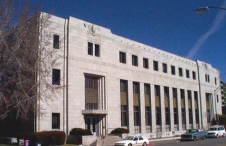Neoclassical Style Architecture in Nevada
A revival of interest in classical models of architecture dates from the World's Columbian Exposition held in Chicago in 1893. The neoclassical style came into vogue during the last decade of the nineteenth century and retained its popularity through the first half of the twentieth century.
Neoclassical buildings employ a wide range of motifs from Greek and Roman architecture. Unlike the earlier Greek revival movement, which called for the use of the narrow side of the rectangular footprint to serve as the front elevation, the broad aspect of a neoclassical building usually included its ceremonial entrance with its characteristic full-height entry porch. Public buildings of the period became the principal manifestation of the neoclassical style although some residential and commercial structures show neoclassical influence. Specific motifs include all the various classical orders of columns, symmetrical design, classical window surrounds, and domes.
The Washoe County Courthouse is one of the more elaborate manifestations of neoclassical architecture in Nevada. Most of Frederick DeLongchamps' courthouses—which began with the Washoe County facility—rely on the neoclassical style, making it nearly synonymous with turn-of-the-century public architecture in the state.









